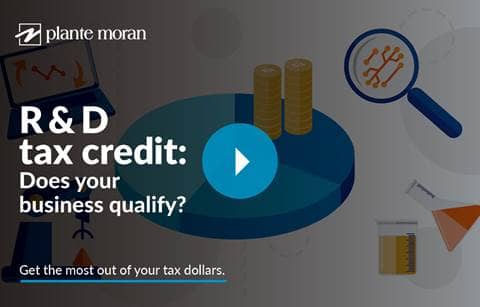The R&D tax credit has been a part of the tax code for more than four decades and is awarded to taxpayers who spend money on performing activities related to the development, design, or improvement of products, processes, techniques, formulas, or software. Claimed on annual federal income tax returns, it results in a dollar-for-dollar reduction of income tax liability. As with all items reported on a federal income tax return, the R&D credit may be disallowed by the IRS, either before or after payment.
R&D tax credit and increased IRS enforcement
Taxpayers have noticed that the IRS has become more aggressive in challenging claimed R&D credits. Given the projected increase in IRS enforcement funding, it’s likely that challenges will increase in the future. Amended tax returns claiming the R&D credit are now subject to additional disclosure requirements and are often carefully scrutinized by the IRS before payment. Even when credits have been granted, the IRS typically has three years from the date of filing the return to initiate an examination and potentially disallow the credits.
Properly documenting the R&D tax credit
Eligibility for the R&D credit is dependent upon many factors. In practice, the IRS frequently disallows credits on the basis of (1) the lack of technical uncertainty with respect to the development; (2) the lack of a process of experimentation with respect to the approach to development; and (3) the lack of contemporaneous supporting documentation for the required elements of the credit. Unfortunately, no hard-and-fast rules apply for settling disputes; rather, the law surrounding the R&D credit is supported by a patchwork of judicial decisions arising from prior disputes between taxpayers and the IRS.
Faced with this reality, some taxpayers will fare better than others — those taxpayers who deploy an “ounce of prevention” should expect a greater chance of success in obtaining the full value of the R&D credit. Prevention can take various forms and often includes proper documentation working with outside providers who understand the R&D credit process from start to finish.
Contemporaneous documentation is critical to success — not only detailing the work performed but also documenting the technical uncertainty in the project as well as the process of experimentation to be followed in order to resolve that uncertainty. As IRS exams often occur years after the R&D work driving the credit is performed, employees involved in the details often have left employment or memories have faded. Reconstructing details can be frustrating for those taxpayers who have counted on their credits.
Accordingly, taxpayers who employ a systematic approach to generating documentation to support the R&D credit are the most prepared for IRS challenges, are the most likely to emerge from a successful examination, and may minimize the IRS’ incentive to challenge their credits in future years.
Working with outside providers for your R&D tax credit
Many taxpayers don’t have the resources to have staff dedicated to studying and supporting the taxpayer’s R&D credit calculation and documentation and instead choose to turn to outside providers. Not all service providers are the same; taxpayers are well-served by those providers who are the most knowledgeable and experienced in the R&D tax credit. While knowledge and expertise are critical, courts and the IRS are often skeptical of work performed by service providers with a conflict of interest arising from the fact that such service providers are paid based on a portion of the resulting credit. As such, taxpayers often find that the ideal provider is one who is compensated on either an hourly of fixed-fee basis and has suitable knowledge and experience in the R&D credit throughout the entire process — from supporting the taxpayer in gathering information to claim the credit to reporting the credit on a return and all the way through the IRS examination process.
Reporting the R&D credit on a tax return is only one step of the process. The “ounce of prevention” for maximizing the benefit of the R&D credit involves a systematic process of gathering relevant, contemporaneous documentation and working with a knowledgeable, experienced service provider free of the conflicts of interest that create skepticism for the IRS when considering the taxpayer’s claimed credit.





